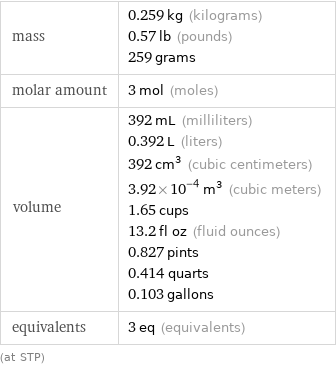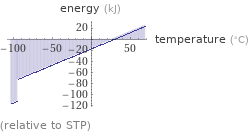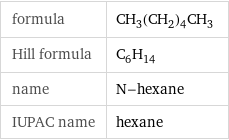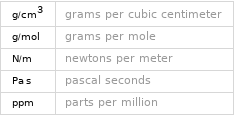Input interpretation

3 mol of N-hexane
Basic properties for 3 mol

mass | 0.259 kg (kilograms) 0.57 lb (pounds) 259 grams molar amount | 3 mol (moles) volume | 392 mL (milliliters) 0.392 L (liters) 392 cm^3 (cubic centimeters) 3.92×10^-4 m^3 (cubic meters) 1.65 cups 13.2 fl oz (fluid ounces) 0.827 pints 0.414 quarts 0.103 gallons equivalents | 3 eq (equivalents) (at STP)
Thermodynamic properties for 3 mol

enthalpy of hydration | -95.7 kJ (kilojoules) | energy content | 12.49 MJ (megajoules) | heat capacity C_p | liquid | 586.8 J/K heat of formation Δ_fH° | gaseous | -500.7 kJ latent heat of vaporization | 97.8 kJ (kilojoules) | latent heat of fusion | 39.2 kJ (kilojoules) |
Units

Energy vs. temperature for 3 mol

(relative to STP)
Units

Phase change energies for 3 mol from 25 °C

energy required to heat to boiling point | 25.7 kJ (kilojoules) energy required to convert to vapor | 97.8 kJ (kilojoules) energy required to heat to boiling point and convert to vapor | 123 kJ (kilojoules) energy released from cooling to freezing point | 70.6 kJ (kilojoules) energy released from converting to solid | 39.2 kJ (kilojoules) energy released from cooling to freezing point and converting to solid | 110 kJ (kilojoules)
Corresponding quantities

sphere radius | 4.538 cm (centimeters) side of a cube | 7.316 cm (centimeters)
Mass composition for 3 mol

C (carbon) | 0.216 kg (83.6%) H (hydrogen) | 42.340 g (16.4%)

Mass composition for 3 mol
Lewis structure

Draw the Lewis structure of N-hexane. Start by drawing the overall structure of the molecule: Count the total valence electrons of the carbon (n_C, val = 4) and hydrogen (n_H, val = 1) atoms: 6 n_C, val + 14 n_H, val = 38 Calculate the number of electrons needed to completely fill the valence shells for carbon (n_C, full = 8) and hydrogen (n_H, full = 2): 6 n_C, full + 14 n_H, full = 76 Subtracting these two numbers shows that 76 - 38 = 38 bonding electrons are needed. Each bond has two electrons, so the above diagram has all the necessary bonds. There are 19 bonds and hence 38 bonding electrons in the diagram. Lastly, fill in the remaining unbonded electrons on each atom. In total, there remain 38 - 38 = 0 electrons left to draw and the diagram is complete: Answer: | |
Chemical names and formulas

formula | CH_3(CH_2)_4CH_3 Hill formula | C_6H_14 name | N-hexane IUPAC name | hexane
Substance properties

molar mass | 86.18 g/mol phase | liquid (at STP) melting point | -95.35 °C boiling point | 68.73 °C density | 0.6603 g/cm^3 surface tension | 0.0184 N/m dynamic viscosity | 3×10^-4 Pa s (at 25 °C) odor | gasoline-like odor threshold | 130 ppm
Units
